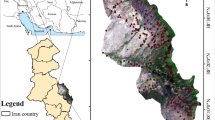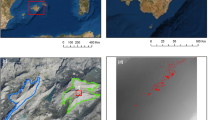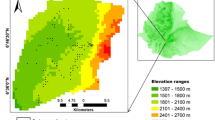Abstract
Invasive plants can alter the function and structure of ecosystems resulting in social, economic, and ecological damage. Effective methods to reduce the dominance of invasive plants are needed. The present study was aimed at modeling the invasive species Leucanthemum vulgare Lam. in the rangelands of the Namin region in northwest Iran, as well as predicting the habitat connectivity of this species to detect areas with high habitat connectivity. Modeling of potential habitats was performed using logistic regression (LR) and maximum entropy (MaxEnt); the ensemble map which resulted from these was used to predict habitat connectivity using the electrical circuit method. Topography (elevation, slope, and aspect), climate (precipitation and temperature), and soil (acidity, electrical conductivity, soil texture, calcium, magnesium, sodium, phosphorus, potassium, organic carbon, organic matter, saturation percentage, and total neutralizing value) were used in this study. The presence and absence points of the L. vulgare were recorded using a stratified-random sampling method by means of a global positioning system. Soil samples were collected at a depth of 0 to 30 cm where L. vulgare was present and also where it was absent. According to the results, in LR, the variables of temperature, phosphorus, organic matter, and sand and in the MaxEnt, the variables of sand, total neutralizing value (TNV), and silt were the most influential factors on the distribution of L. vulgare. The appraisal of the MaxEnt performance and the precision of the model prediction were 0.97. The Kappa indices for the predicted map obtained from the LR and MaxEnt models were 0.80 and 0.73, respectively. The models’ evaluation indicated that both models were able to predict the distribution of L. vulgare habitats with a high level of accuracy; however, LR was more reliable. According to the LR prediction, 9.91% (10,556.25 ha) of the Namin region was attacked by L. vulgare. Connectivity assessment showed that the current density spread of L. vulgare continued from the northeast of the Namin region toward the southeast. On the other hand, the higher current density spread was demonstrated in the eastern region (rangelands adjacent to Fandoghlu forests), and other rangelands which are more threatened by the invasion of L. vulgare. Identifying sites exposed to invasive species can help implement programs to prevent invasive species from invading areas where management and prevention should be implanted to prevent and/or reduce the spread.








Similar content being viewed by others
Data availability
The datasets generated during and/or analyzed in the current study are available from the corresponding author on reasonable request.
References
Adhikari, A., Rew, L. J., Mainali, K. P., Adhikari, S., & Maxwell, B. D. (2020). Future distribution of invasive weed species across the major road network in the state of Montana, USA. Regional Environmental Change, 20(60), 14p. https://doi.org/10.1007/s10113-020-01647-0
Aghajanlou, F., Ghorbani, A., Zare Chahouki, M.A., & Hashemimajd, K. (2018). The impact of environmental factors on distribution of Ferula ovina (Boiss.) Boiss. in northwest Iran. Applied Ecology and Environmental Research, 16(2), 977–992.
Ahmad, R., Khuroo, A. A., Charles, B., Hamid, M., Rashid, I., & Aravind. N. A. (2019). Global distribution modelling, invasion risk assessment and niche dynamics of Leucanthemum vulgare (Ox-eye Daisy) under climate change. Scientific Reports, 9(1). https://doi.org/10.1038/s41598-019-47859-1
Ali Ehyaei, M., & Behbehani Zade, A. A. (1993). Methods of soil chemical analysis. Soil and Water Research Institute of Agricultural Extension and Education, 893, 128p.
Almasieh, K., Zoratipour, A., & Negaresh, K. (2020). Habitat suitability and connectivity assessment for a range plant Behbahanian knapweed (Centaurea pabotii) in Southwest of Iran as an invader for wheat fields. Journal of Rangeland and Watershed Management, 73(3), 587–598.
Borna, F., Tamartash, R., Tatian, M., & Gholami, V. (2020). Determination of the contribution environmental factors affecting the predicting distribution habitat Artemisia aucheri Boiss in the watershed of Balade Noir. Journal of Watershed Management Research, 11(21), 119–128.
Bouyoucos, G. J. (1962). Hydrometer method improved for making particle size analyses of soils. Agronomy Journal, 54(5), 464–465.
Clements, D. R., Cole, D. E., Darbyshire, S., King, J., & McClay, A. (2004). The biology of Canadian weeds. 128. Leucanthemum vulgare Lam. Canadian Journal of Plant Science, 84(1), 343–363.
Cohen, J. (1960). A coefficient of agreement of nominal scales. Educational and Psychological Measurement, 20, 37–46.
Cole, D. E. (1998). Effect of competition on growth of ox-eye daisy (Chrysanthemum leucanthemum L.) in pastures and hay land (p. 156). M.Sc. Thesis, University of Alberta, Edmonton, AB.
Cordiera, J. M., Loyolab, R., Rojas-Sotoc, O., & Noria, J. (2020). Modeling invasive species risk from established populations: Insights for management and conservation. Perspectives in Ecology and Conservation, 18, 132–138.
Dallal, G. E. (2001). Collinearity. http://www.tufts.edu/gdallal/collin.htm
Dickson, B. G., Albano, Ch. M., Gray, M., McClure, M. L., Theobald, D., et al. (2019). Circuit-theory applications to connectivity science and conservation. Conservation Biology, 33, 239–249.
Dubuis, A. (2013). Predicting spatial patterns of plant biodiversity: From species to communities (p. 295p). University of Lausanne.
Elith, J., & Leathwick, J.R. (2009). The contribution of species distribution modelling to conservation prioritization. In A. Moilanen, K. A. Wilson, & H. Possingham, (Eds.), Spatial conservation prioritization: quantitative methods (Volume 1, pp. 70–93). Oxford University Press, New York, USA; Oxford, UK.
Elith, J., Kearney, M., & Phillips, S. (2010). The art of modelling range-shifting species. Methods in Ecology and Evolution, 1, 330–334.
Elith, J., Phillips, S. J., Hastie, T., Dudík, M., Chee, Y. E., & Yates, C. J. (2011). A statistical explanation of MaxEnt for ecologists. Diversity and Distributions, 17(1), 43–57. https://doi.org/10.1111/j.1472-4642.2010.00725.x
Elith, J. (2016). Predicting distributions of invasive species. arXiv, 28p.
Emami, A. (1997). Methods of chemical analysis of plant. Technical publication, No. 982, (Vol.1), Soil and Water Research Institute, Tehran.
Esfanjani, J., Ghorbani, A., Moameri, M., Zare Chahouki, M.A., Esmali Ouri, A., & Mirzaei Mossivand, A. (2020). Prediction of distribution of Prangos uloptera DC. using two modeling techniques in Southern rangelands of Ardabil province, Iran. Journal of Rangeland Science, 10(2), 137–148.
Fischer, D., Thomas, S. M., Suk, J. E., Sudre, B., Hess, A., Tjaden, N. B., et al. (2013). Climate change effects on Chikungunya transmission in Europe: Geospatial analysis of vector’s climatic suitability and virus’ temperature requirements. International Journal of Health Geographics, 12, 51. https://doi.org/10.1186/1476-072X-12-51
Fournier, A., Penone, C., Pennino, M. G., & Courchamp, F. (2019). Predicting future invaders and future invasions. PNAS, 16, 7905–7910. https://doi.org/10.1073/pnas.1803456116
Fridley, J. D., Stachowicz, J. J., Naeem, S., Sax, D. F., Seabloom, E. W., Smith, M. D., Stohlgren, T. J., Tilman, D., & Holle, B. V. (2007). The invasion paradox: Reconciling pattern and process in species invasions. Ecology, 88, 3–17. https://doi.org/10.1890/00129658(2007)88[3:tiprpa]2.0.co;2
Ghorbani, A., Samadi Khangah, S., Moameri, M., & Esfanjani, J. (2020). Predicting the distribution of Leucanthemum vulgare Lam. using logistic regression in Fandoghlou rangelands of Ardabil province, Iran. Journal of Rangeland Science, 10(1), 98–111.
Hanks, E. M., & Hooten, M. B. (2013). Circuit theory and model-based inference for landscape connectivity. Journal of the American Statistical Association, 108(501), 22–33. https://doi.org/10.1080/01621459.2012.724647
Hao, T., Elith, J., Guillera-Arroita, G., & Lahoz-Monfort, J. J. (2019). A review of evidence about use and performance of species distribution modelling ensembles like BIOMOD. Diversity and Distributions, 25, 839–852. https://doi.org/10.1111/ddi.12892
Holm, L., Pancho, J. V., Herberger, J. P., & Plucknett, D. L. (1979). A geographical atlas of world weeds. Wiley.
Hong, S. H., Lee, Y. H., Lee, G., Lee, D. H., & Adhikari, P. (2021). Predicting impacts of climate change on northward range expansion of invasive weeds in South Korea. Plants, 10, 1604. https://doi.org/10.3390/plants10081604
Hosmer, D. W., & Lemeshow, S. (1980). A comparison of goodness-of-fit tests for the multiple logistic regression models. Communications in Statistics-Theory and Methods, 9, 1043–1069.
Howarth, S. E., & Williams, J. T. (1968). Biological flora of the British Isles. Chrysanthemum Leucanthemum L. Journal of Ecology, 56, 585–595.
Jackson, M. A. (1962). Soil chemical analysis. Constable and Co Ltd Publication.
Jacobs, J. (2008). Ecology and management of oxeye daisy (Leucanthemum vulgare Lam.). Invasive Species Technical, 19, 10–15.
Jiménez-Valverde, A., Peterson, A. T., Soberón, J., Overton, J. M., Aragón, P., & Lobo, J. M. (2011). Use of niche models in invasive species risk assessments. Biological Invasions, 13, 2785–2797.
Jones, J. B. (2001). Laboratory guide for conducting soil tests and plant analysis. Boca Raton. London (pp. 152–153). New York and Washington, D.C.CRC Press.
McDougall, K., Wright, G., & Peach, E. (2018). Coming to terms with ox-eye daisy (Leucanthemum vulgare) in Kosciuszko National Park, New South Wales. Ecological Management & Restoration, 19, 4–13.
McDowell, W. G., & Byers, J. E. (2019). High abundance of an invasive species gives it an outsized ecological role. Freshwater Biology, 64(3), 577–586. https://doi.org/10.1111/fwb.13243
McRae, B. H. (2006). Isolation by resistance. Evolution, 60, 1551–1561.
McRae, B. H., Dickson, B. G., Keitt, T. H., & Shah, V. B. (2008). Using circuit theory to model connectivity in ecology, evolution and conservation. Ecology, 89(10), 2712–2724.
McRae, B., & Shah, V. B. (2011). Circuitscape user guide. The University of California, Santa Barbara. Available at: http://www.circuitscape.org
McRae, B., Shah, V. B., & Edelman, A. (2016). Circuitscape: Modeling landscape connectivity to promote conservation and human health.
Merow, C., Smith, M. J., & Silander, J. A., Jr. (2013). A practical guide to MaxEnt for modeling species’ distributions: What it does, and why inputs and settings matter. Ecography, 36(10), 1058–1069. https://doi.org/10.1111/j.1600-0587.2013.07872.x
Monserud, R. A., & Leemans, R. (1992). Comparing global vegetation maps with the Kappa statistic. Ecological Modelling, 62, 275–293. https://doi.org/10.1016/0304-3800(92)90003-W
Murphy, J., & Riley, P. (1962). A modified single solution method for determination of phosphate in natural water. Journal of Analytica Chimica Acta, 27, 31–36.
Negga, H. E. (2007). Predictive modelling of amphibian distribution using ecological survey data: A case study of Central Portugal, MSc thesis, International Institute for Geo-Information Science and Earth Observation, Enschede, The Netherlands (pp. 380).
Olson, B. E., & Wallander, R. T. (1999). Oxeye daisy. In R. L. Sheley & J. K. Petroff (Eds.), Biology and management of noxious rangeland weeds (pp. 282–289). Oregon State University Press.
Page, A. L., Miller, R. H., & Keeney, D. R. (1982). Methods of soil analysis, part 2, chemical and microbiological properties. American Society of Agronomy (pp. 711–733). Soil Science of America Publishers, Madison. Wisconsin.
Phillips, S. J., Anderson, R. P., & Schapire, R. E. (2006). Maximum entropy modeling of species geographic distributions. Ecological Modelling, 190, 231–259.
Roever, C. L., van Aarde, R. J., & Leggett, K. (2013). Functional connectivity within conservation networks: Delineating corridors for African elephants. Biological Conservation, 157, 128–135.
Samadi, S., Ghorbani, A., Moameri, M., & Abbasi Khalaki, M. (2019). Ecological factors affecting on distribution of invasive species Leucanthemum vulgare Lam. in Fandoghlou rangelands of Ardabil province. Iranian Journal of Rangeland, 13(2), 125–138.
Samadi, S., Ghorbani, A., Moameri, M., Abbasi, M., & Bidar, M. (2020). The impact of invasive species Leucanthemum vulgare Lam. on vegetation characteristics of Fandoghlou rangelands in Namin county, Ardabil, Iran. Iranian Journal of Rangeland, 14(3), 379–392.
Samadi, S., Ghorbani, A., & Moameri, M. (2021). Relationship between ecological species groups and environmental factors in Fandoghlou rangelands of Ardabil Iran. Ecopersia, 9(2), 131–138.
Sandilyan, S., & Vairvel, S. M. (2020). Co-occurrence of Leucanthemum vulgare and Lupinus polyphyllus in Gulmarg Region of Kashmir Valley will accelerate the depletion of native diversity?. Field investigations are need of the hour. Indian Forester, 146(3), 267–269. https://doi.org/10.36808/if/2020/v146i3/147454
Statistical Yearbook of Ardabil province. (2019). Publications of the Plan and Budget Organization of Iran. 1–694.
Stephens, D. (2017). Field guide for managing oxeye daisy in the Southwest. USDA Forest Service, 9p.
Stutz, S., Mraz, P., Hinz, H. L., Muller-Scharer, H., & Schaffner, U. (2018). Biological invasion of oxeye daisy (Leucanthemum vulgare) in North America: Pre-adaptation, post-introduction evolution, or both? PLoS One, 13, e0190705. https://doi.org/10.1371/journal.pone.0190705
Thuiller, W., & Arau ́jo, M.B., & Lavorel, S. (2003). Generalized model vs. classification tree analysis: Predicting spatial distributions of plant species at different scales. Journal of Vegetation Science, 14, 669–680.
Teimoorzadeh, A., Ghorbani, A., & Kavianpoor, A. H. (2015). Study on the flora, life forms and chorology of the south eastern of Namin forests (Asi-Gheran, Fandoghloo, Hasani and Bobini) Ardabil Province. Journal of Plant Biology, 28(2), 264–275.
Walden-Schreiner, C., Leung, Y. F., Kuhn, T., Newburger, T., & Tsai, W. L. (2017). Environmental and managerial factors associated with pack stock distribution in high elevation meadows: Case study from Yosemite National Park. Environmental Management, 193, 52–63. https://doi.org/10.1016/j.jenvman.2017.01.076
Walkley, A., & Black, I. A. (1934). An examination of digestion method for determining soil organic matter, and a proposed modification of the chromic acid titration method. Soil Science, 37, 29–38.
Wharton, D., Wright, S. T., & Wang, Y. (2012). Distance-based multivariate analyses confound location and dispersion effects. Journal of Methods in Ecology and Evaluation, 3(1), 89–101.
Wilkinson, J. W., & Starnes, T. (2016). Ten years of Jersey Toadwatch: Analysis & recommendations. ARC Research Report 16/01.
Williams, M., Zalasiewicz, J., Haff, P. C., Barnosky, A. D., & Ellis, E. C. (2015). The Anthropocene Biosphere. the Anthropocene Review, 2, 196–219. https://doi.org/10.1177/2053019615591020
Yan, H., Feng, L., Zhao, Y., Feng, L., Zhu, Ch., Qu, Y., & Wang, H. (2020). Predicting the potential distribution of an invasive species, Erigeron canadensis L., in China with a maximum entropy model. Global Ecology and Conservation, 21, 1–13. https://doi.org/10.1016/j.gecco.2019.e00822
Yang, X. Q., Kushwaha, S. P. S., Saran, S., Xu, J., & Roy, P. S. (2013). Maxent modeling for predicting the potential distribution of medicinal plant, Justicia adhatoda L. in Lesser Himalayan foothills. Ecological Engineering, 51, 83–87. https://doi.org/10.1016/j.ecoleng.2012.12.004
Zare Chahouki, M. A. (2010). Data analysis in natural resources research using SPSS software. University of Tehran press, 310 p.
Zhang, J., Jiang, F., Li, G., Qin, W., Li, S., Gao, H., Cai, Z., Lin, G., & Zhang, T. (2019). Maxent modeling for predicting the spatial distribution of three raptors in the Sanjiangyuan National Park China. Ecology and Evolution, 9(11), 6643–6654. https://doi.org/10.1002/ece3.5243
Funding
The research was the PhD thesis of the first author under the supervision and advisory of the co-authors, and it was funded by the University of Mohaghegh Ardabili, Iran, under the terms of Student Grant.
Author information
Authors and Affiliations
Contributions
S. Samadi Khanghah (first author), original researcher, introduction, author, methodologist, statistical analyst, writing-review and editing (35%); M. Moameri (second author), original researcher, methodologist, statistical analyst, discussion author, writing-review and editing (30%); A. Ghorbani (third author), methodologist, statistical analyst (20%); R. Mostafazadeh (fourth author), assistant researcher, statistical analyst, writing-review and editing (10%); A. Biswas (fifth author), assistant researcher, writing-review and editing (5%). All authors have read and agreed to the published version of the manuscript.
Corresponding author
Ethics declarations
Conflict of interest
The authors declare no competing interests.
Additional information
Publisher's Note
Springer Nature remains neutral with regard to jurisdictional claims in published maps and institutional affiliations.
Rights and permissions
About this article
Cite this article
Khanghah, S.S., Moameri, M., Ghorbani, A. et al. Modeling potential habitats and predicting habitat connectivity for Leucanthemum vulgare Lam. in northwestern rangelands of Iran. Environ Monit Assess 194, 109 (2022). https://doi.org/10.1007/s10661-021-09716-5
Received:
Accepted:
Published:
DOI: https://doi.org/10.1007/s10661-021-09716-5




